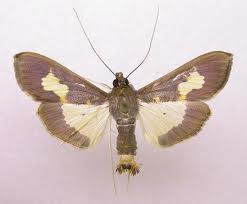Pickleworm

Pickleworm moth
Photo: hawaii.gov
Problem
Pickleworm attacks all of the cucurbits (cucumber, zucchini, squash, pumpkin.) The plant will be healthy and vigorous; suddenly you notice that the fruit has started to rot or that the stem has collapsed and the plant is dying.
Description
Pickleworm moths are active at night, particularly in the hours just after sundown. The moths have a wing span of about 3 cm and are brown with a light tan or yellowish section in the middle.
Pickleworms feed on cucurbit flowers and fruit. You will see a small hole from which frass is extruded. They may also attack the vines, causing the plant to wilt.
Information
Control
Pickleworm moths are not attracted to light traps and pheromone traps do not work well for this species. Bug zappers may help however. We recommend trying Bt which disrupts the feeding of the larvae. However, because the larvae feed within the fruit and the stem of the plant, success may be limited. Another alternative is for home gardeners to cover the crop at dusk with a mosquito net (available at the Army Surplus store on Mamo Street, Hilo) which will prevent access by the moth. You must remove the net each morning to allow honeybees and other insects to pollinate the crop. Be consistent; I found that forgetting to cover my cucumbers occasionally allowed the pickleworm to get established. You could look for netting with ¾ inch spacing since the adult pickleworm moth has a wingspan of a little over 1 inch; given netting with the right spacing, moths cannot get in but honeybees can, allowing you to leave the net over the plants at all times.
Some home gardeners have more success when they plant in the fall rather than in the spring and summer when moth populations are highest. With squash, you could also try planting resistant varieties such as Butternut 23, Summer Crookneck, Early Prolific Straightneck, and Early Yellow Summer Crookneck. Extension Agent, Andrew Kawabata, recommends looking for greenhouse cucumber seeds which are self-pollinating. Since they are self-pollinating, you can cover plants with a net and leave on all day.
Chemical Control: Talk to an extension agent about pesticide use.
Kendal Lyon, Hawaii Island Master Gardeners

